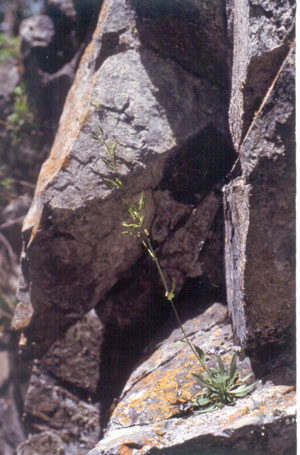DACF Home → Bureaus & Programs → Maine Natural Areas Program → Communities, Plants, and Animals → Rare Plants → Draba arabisans

Draba arabisans Michx.
Rock Whitlow-grass
- State Rank: S1
- Global Rank: G5
- State Status: Threatened
Habitat: Calcareous or argillaceous rocks. [Rocky summits and outcrops (non-forested, upland)]
Range: Newfoundland and Labrador to Maine, Vermont, northern New York and western Ontario.
Aids to Identification: Rock whitlow-grass (not related to grasses) grows in tufts, forming mats about 15 cm across, with thin, narrow leaves 2-4 cm long. The flowering stems are 15-45 cm high, with an elongate cluster of small, white, 4-petaled flowers, which later develop into oblong pods. It closely resembles D. glabella (ranked S1 in Maine). The two can be separated based on the stellate hairs on the underside of the leaves: D. arabisans has sessile stellate hairs whereas D. glabella has stalked stellated hairs.
Ecological characteristics: This species is typically found growing on rock overhangs and cliffs.
Phenology: Flowers May - July.
Family: Brassicaceae
Synonyms: Draba incana L. var. arabisans (Michx.) S. Wats.
Known Distribution in Maine: This rare plant has been documented from a total of 7 town(s) in the following county(ies): Aroostook, Franklin, Piscataquis.
Reason(s) for rarity: Southeastern limit of its range.
Conservation considerations: Known populations are in remote locations, not particularly vulnerable to human activities.